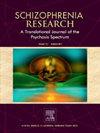Advancing the sensori-/psychomotor domain in schizophrenia spectrum disorders: From clinical observation to translational innovation
IF 3.5
2区 医学
Q1 PSYCHIATRY
引用次数: 0
Abstract
Sensori-/psychomotor dysfunction has historically been an underrecognized domain in schizophrenia spectrum disorders (SSD), often overshadowed by a narrow focus on medication-induced side effects such as acute extrapyramidal motor symptoms, akathisia, dystonia, parkinsonism, and tardive dyskinesia. Two decades ago, research in this area was largely confined to these pharmacologically related phenomena, as well as to neurological soft signs (NSS) and catatonia. In the last ten years, however, the sensori-/psychomotor domain has garnered renewed interest as a core feature of SSD—relevant not only for symptom profiling but also for early detection, prognostic stratification, and individualized treatment planning across the lifespan. This narrative review synthesizes major advances from the past five years across Psychiatry, Neuroscience, Human Movement Science, and Affective Computing. It highlights a paradigm shift from traditional hand-based sensori-/psychomotor assessments toward novel, scalable approaches for investigating sensori-/psychomotor dysfunction. Emerging tools—such as actigraphy, 3D motion capture systems, standardized sensorimotor tasks, and multimodal neuroimaging—now allow for more objective, multimodal assessment of sensori-/psychomotor behavior, including gesture dynamics and patterns of physical inactivity. In parallel, computational innovations have enabled the large-scale analysis of sensori-/psychomotor abnormalities, including retrospective mining of unstructured clinical notes through natural language processing and machine learning techniques. Together, these developments underscore the shifting view of sensori-/psychomotor dysfunction as more than behavioral epiphenomena or drug effects. We argue that the integration of emerging technologies and refined methodologies into clinical workflows is essential for translating research findings into personalized, real-world care of mental disorders across the lifespan.
推进精神分裂症谱系障碍的感觉/精神运动领域:从临床观察到转化创新。
在精神分裂症谱系障碍(SSD)中,感觉/精神运动功能障碍一直是一个未被充分认识的领域,通常被药物引起的副作用(如急性锥体外系运动症状、无运动障碍、肌张力障碍、帕金森病和迟发性运动障碍)的狭隘关注所掩盖。二十年前,这一领域的研究主要局限于这些与药理学相关的现象,以及神经软症状(NSS)和紧张症。然而,在过去的十年中,感觉/精神运动域作为ssd的核心特征重新引起了人们的兴趣,不仅与症状分析有关,而且与早期发现、预后分层和整个生命周期的个性化治疗计划有关。这篇叙述性综述综合了过去五年在精神病学、神经科学、人体运动科学和情感计算方面的主要进展。它强调了从传统的基于手的感觉/精神运动评估到研究感觉/精神运动功能障碍的新颖,可扩展的方法的范式转变。新兴的工具——比如活动描记术、3D动作捕捉系统、标准化的感觉运动任务和多模态神经成像——现在允许对感觉/精神运动行为进行更客观、多模态的评估,包括手势动力学和身体不活动的模式。与此同时,计算创新使得对感觉/精神运动异常的大规模分析成为可能,包括通过自然语言处理和机器学习技术对非结构化临床记录进行回顾性挖掘。总之,这些发展强调了感觉/精神运动功能障碍不仅仅是行为现象或药物作用的转变。我们认为,将新兴技术和完善的方法整合到临床工作流程中,对于将研究成果转化为贯穿整个生命周期的个性化、现实世界的精神障碍护理至关重要。
本文章由计算机程序翻译,如有差异,请以英文原文为准。
求助全文
约1分钟内获得全文
求助全文
来源期刊

Schizophrenia Research
医学-精神病学
CiteScore
7.50
自引率
8.90%
发文量
429
审稿时长
10.2 weeks
期刊介绍:
As official journal of the Schizophrenia International Research Society (SIRS) Schizophrenia Research is THE journal of choice for international researchers and clinicians to share their work with the global schizophrenia research community. More than 6000 institutes have online or print (or both) access to this journal - the largest specialist journal in the field, with the largest readership!
Schizophrenia Research''s time to first decision is as fast as 6 weeks and its publishing speed is as fast as 4 weeks until online publication (corrected proof/Article in Press) after acceptance and 14 weeks from acceptance until publication in a printed issue.
The journal publishes novel papers that really contribute to understanding the biology and treatment of schizophrenic disorders; Schizophrenia Research brings together biological, clinical and psychological research in order to stimulate the synthesis of findings from all disciplines involved in improving patient outcomes in schizophrenia.
 求助内容:
求助内容: 应助结果提醒方式:
应助结果提醒方式:


